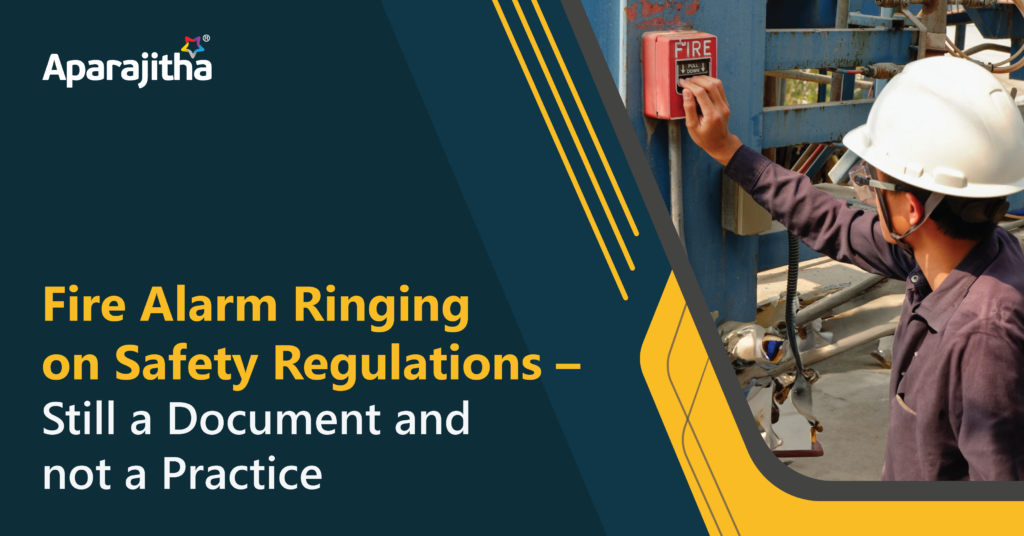And we add another article to the plethora of articles and news on fire instances and safety regulations thereof. The recent incident of fire in Rajkot Gaming Centre and the pediatric hospital in East Delhi, resulting in casualties, has made the netizens frantic about the fire safety regulations. A total of approximately 40 casualties have been reported so far from both the incidents. However, one needs to understand that this is not the first or the last instance to be reported. The reasons for the fire in Rajkot varies from poor construction material, welding work being carried on next to the gaming centre which resulted in short circuit, only single point of entry and exit, improper management of the crowd etc. In the hospital in Delhi, the real reason for fire is yet not clear, however, illegal oxygen cylinder filling is being contemplated as one of the reasons.
Time after time, we hear about such instances, however, we fail to understand or comply with the fire safety regulations. One needs to understand that just like other regulatory compliances, fire norms must not only be viewed with an intent of burden but the spirit of safety, especially in a time when most of the nation is facing a heat wave.
In a report published by the National Institute of Disaster Management (March 2020) , it was noted that in a period from 2014 to 2018, around 83,872 fire incidents were reported in India. As population increases in India, the risk of exposing oneself to such fire instances also increases. The small, cramped up urbanization projects are a matter of grave concern and one can only hope that compliance to the fire safety regulatory framework can aid in avoiding or managing such risks. Tightly packed dwelling units in slums and squatter settlements are high risk areas in cities. Few cases in the past which should have served as a learning for other establishment to ensure fire safety compliances are:
a. Dabwali Fire: Dabwali, a municipality located in Sirsa District, Haryana, faced a fire accident during a school annual function. The set up was temporary tent (highly inflammable) appropriate to accommodate a crowd of almost 400 people. However, on that particular day, the list of invitees reached upto 1200 people. Due to a short circuit to the right of the single exit point, fire broke out. Only 500 out of the 1200 people could exit and within 7 minutes of the fire, the point, the whole place was engulfed. The fire result in death of 446 deaths, leaving nearly 200 with burn injuries .
b. Uphaar Cinema, Delhi: Located in the posh area of South Delhi, the Cinema theatre caught fire in 1997 when one of its transformers caught fire in the early hours. The Fire brigade was immediately called and within an hour the fire was brought under control. By early afternoon, the electricity was restored. However, another incident of fire occurred on the same day in the evening when one of its shows was running, which resulted in death of 59 people and injured over 100 people.
c. AMRI Hospital fire: Kolkata is a city with the highest number of persons perhousehold (11 per household) in the country (2014) making it highlyvulnerable in case of a fire because of the high exposure of people.In December 2011, the Advanced Medicareand ResearchInstitute (AMRI)Hospital, Dhakuria,Kolkata, witnessed a massive fire early in the morning, in its basement, allegedly highly inflammable materials such as diesel, motor oil etc. were store, which lead to quick
escalation of the fire. Further, the Air-Conditioning ducts sucked on the poisonous gases and spread it through the entire building. Glass exteriors trapped these smokes and suffocated the patients. There was no emergency evacuation plan in place. 93 deaths were reported, out of which the worst affected departments were ICU and NITU.
d. Sivakasi Factory Explosion: Sivakasi, Tamil Nadu is the hub for fireworks factories and in September 2012, Sivakasi experienced one of the most violent fire incidents ever. The friction between thechemicals supposedly ledto an explosion at oneunit which set a deadlychain of explosions thatshattered all the 48 sheds that were located within the premises of the factory, trapping over 300 persons who were at the unit. The strong wind that day added to the severity of the fire. An average of 3 instances of fire are reported in Sivakasi every year.
The list goes on. Kolkata Market Fire (February 2013), Puttingal Devi Temple Fire (April 2016), Surat Fire (May 2019), and many more are all examples from which India needs to learn. There is an urgent requirement of paradigm shift from firefighting to fire prevention. The lessons learned so far out of all these instances are common, such as, unauthorized construction and lack of enforcement of guidelines for temporary structures, use of flammable materials, overcrowding, violation of safety norms, violation of electrical norms, violation of building and construction norms, lack of dedicated burn units, lack of preparedness measures, structural and planning irregularities, casual attitude towards fire safety etc.
The Ministry of Home Affairs has urged all the state governments to incorporate and implement the latest National Building Code of India 2016 Part – IV, “Fire & Life Safety,” in their building bye-laws. Therefore every new construction will have to obtain a provisional “No Objection Certificate” (NOC) to ensure that fire safety compliant norms are met. This NOC should be obtained before the construction begins, after the plans and drawings are ready. This Fire NOC is a document that essentially certifies the existence of fire safety equipment in a building it’s a crucial requirement for obtaining building plan approval.
It’s crucial to understand that fire regulations are under the State subject and therefore, differ from state to state. They also differ based on the category, type, height, and area of a building. Securing a Fire License from the Fire Services Department of the respective State Governments, can ensure that the residential or commercial property is fire-resistant. Fire incidents can occur unexpectedly, so it’s vital for buildings exceeding 15 meters in height to obtain a Fire NOC. This certification confirms that the property has implemented all essential fire safety measures and is equipped to manage potential fire emergencies. It is very crucial to understand the specific norms which are applicable to that particular state and accordingly comply with them.
The legal consequences of not obtaining a fire NOC varies depending upon the state that building in and also, according to the laws applicable, such as criminal law or fire safety laws. There is a great amount of divergence among the state laws on matter of punishments for violation of fire regulations. So, it can vary from a meagre fine of Rs. 500 to a fine of Rs. 50,000/- and even closure of the establishment in some cases. In addition to the fire safety laws, Section 285 of the Indian Penal Code (IPC) provides that any person who acts negligently with fire, in a manner endangering human life, will be punishable with imprisonment of up to 6 months or fine of RS. 1,000. In case the building is owned by a Corporate Entity, then the Directors and the Management is to be responsible for ensuring that all fire related compliances are met with. In case of violation, the Directors will be held liable, following with financial as well as criminal liabilities. In the Uphaar Cinema case, referred above, the trial court in 2007 found Sushil Ansal and Gopal Ansal, the owners of Uphaar Cinema, guilty for causing death due to negligence section 304 A of IPC and they were sentenced to two years of imprisonment. Moreover in 2015 the Supreme Court ordered them to pay 30 crores each for establishing trauma care centre as punitive damages, failing which they will have to undergo rigorous imprisonment of 2 years.
Some of the action strategies which could be referred for way forward are:
a. Widescale audit on the existing establishments towards fire safety –there is an urgent need of the hour that every authority should audit all the existing establishments towards the compliances of fire safety norms. Individuals or establishment owners need to proactively learn from the instances and take measures towards higher compliance.
b. Strengthening guidelines and safety framework –the government authorities need to revise the existing guidelines and safety framework.
c. Stricter enforcement of the fire safety norms and regulations, violation of which should result in heavy penalty –the Government needs to put in place stricter mechanism for ensuring that the licenses and measures are up – to date. Surprise inspections or calling for a report in a timely manner, will ensure that the establishment / business owners are also aware of the compliances they are supposed to meet. Violations should be penalized heavily or license cancellation will act a strict guiding principle for ensuring higher compliances.
d. Upgradationof fire-fighting equipment and infrastructure –Infrastructure should have adequate functioning equipment and approvals should be granted only after inspection has been made thereof. Many instances have been reported, where the fire rescue team could not function properly due to impediments created by the improper infrastructure. The non – compliance with these requirements should be adequately penalized.
e. Mainstreaming of fire risks mitigation and management in urbanplanning and development – Every building owner must analyse the fire risks that can prevail and pre – plan mitigation plans. These should be made part of the applications being made to the developmental authorities for approval. Currently, there seems to be a lack of such regulations in urban and regional planning guidelines.
f. Social capital towards fire safety norms – Last, but not the least, increasing awareness need to be made a major step in mitigating fire risks. From college students to urban planners to public in general, people need to be aware of steps to be taken in case of a fire. Better practices need to be made common for public to follow to avoid risks.
Stay informed on the latest government regulations and compliance updates!
Enquire Now to keep yourself compliant and ahead of the curve!
[1]Ministry of Home Affairs, Government of India
[1]Punjab & Haryana High Court, 2009







